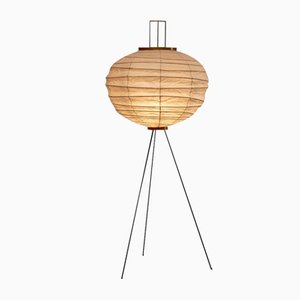
Sculptor, designer, architect, and craftsman Isamu Noguchi was born Isamu Gilmour in Los Angeles in 1904 to Japanese poet Yonejiró (Yone) Noguchi and American writer Leonie Gilmour. He moved with his mother to Japan when he was two years old. In 1918, he returned to the U.S. to study at a high school in Indiana. Four years later, he graduated under the taken name of Sam Gilmour and enrolled at New York’s Columbia University to study medicine. With a growing desire to explore sculpture, he began taking night classes at the Leonardo da Vinci Art School in 1924. He dropped out of Columbia soon after and renamed himself Isamu Noguchi. In 1927, he won a Guggenheim Fellowship and traveled to Paris to assist sculptor Constantin Brancusi. The sculptural sensibility Noguchi encountered there influenced his aesthetic. His work—which ultimately spanned sculpture, gardens, furniture, lighting, architecture, set design, and ceramics—was characterized by simplicity and organic abstraction, a blurring of the artistic disciplines, and simultaneously elevated by a sense of experimentation and collaboration with other artists.
Noguchi returned to the U.S. in 1929 and befriended R. Buckminster Fuller and choreographer Martha Graham, which led to a series of creative collaborations. Between 1930 and 1932, Noguchi traveled to Paris, Beijing, and Japan, finding himself particularly inspired by ancient Buddhist rock gardens. In 1937, he designed his first mass-manufactured piece, the Zenith Radio Nurse intercom. In 1942, he set up a studio in New York’s Greenwich Village neighborhood.
During World War II, Noguchi campaigned to improve the lives of interned Japanese-Americans in the U.S. In 1950, after marrying Japanese movie star Yamaguchi Yoshiko, Noguchi returned to Japan to design a memorial garden dedicated to his father at Keiõ University. In 1951, he contributed to Japanese reconstruction by helping revive the city of Gifu’s paper lantern industry with a modernization of the lantern’s design.
In 1961, he converted a factory in Long Island City, New York, into a home and studio; the space ultimately became the Noguchi Museum. In his later years, he maintained studios in both Japan and the U.S. Between the 1950s and 1980s, Noguchi designed stone gardens for UNESCO in Paris, Yale University, and the Israel Museum in Jerusalem; sets for choreographer Merce Cunningham; and furniture for the likes of Herman Miller and Knoll International.
Noguchi died in New York in 1988.



